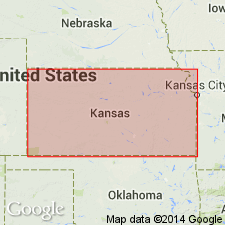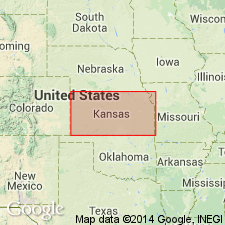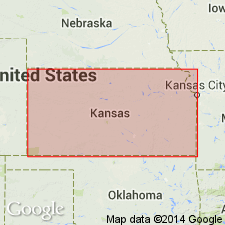
- Usage in publication:
-
- Ellsworth formation
- Modifications:
-
- Overview
- Dominant lithology:
-
- Sandstone
- Shale
- AAPG geologic province:
-
- Central Kansas uplift
Summary:
Ellsworth formation. Yellow-brown sandstone and reddish or varicolored shale mostly nonmarine. Thickness 25 to 200 feet. Includes Rocktown sandstone above and Terra Cotta shale below. Unconformable below Solomon formation (new) and above Belvidere formation. Age is Cretaceous (Comanche).
[Type locality not designated. Origin of name not stated.] Probably named from occurrences in vicinity of Ellsworth, Ellsworth Co., central KS.
[According to D.F. Merriam, 1963 (Kansas Geol. Survey Bull., no. 162, App. B, Catalog of Mesozoic nomenclature for Kansas), name appears on a chart (Moore, 1935) with no explanation except that classification of Dakota beds is in doubt awaiting completion of studies by A.C. Tester; later the name appeared on the Geologic Map of Kansas (Moore and Landes, 1937). Plummer and Romary (1942) credit the name to Tester as appearing on Moore's chart.]
Source: US geologic names lexicon (USGS Bull. 1200, p. 1242); supplemental information from Kansas Geol. Survey Bull., no. 162.

- Usage in publication:
-
- Ellsworth formation
- Modifications:
-
- Areal extent
- AAPG geologic province:
-
- Central Kansas uplift
Summary:
Ellsworth formation of Dakota group. Mapped with Dakota group. Age is Late Cretaceous.
Source: US geologic names lexicon (USGS Bull. 1200, p. 1242).

- Usage in publication:
-
- Ellsworth formation[†]
- Modifications:
-
- [Abandoned]
- AAPG geologic province:
-
- Central Kansas uplift
Summary:
Pg. 153. [†Ellsworth formation abandoned.] Dakota formation, as herein defined, contains stratigraphic units formerly called "Rocktown channel sandstone," "Ellsworth formation," "Solomon formation," "Reeder sandstone," "Marquette sandstone," "Spring Creek clay," and others.
Source: US geologic names lexicon (USGS Bull. 1200, p. 1242).
For more information, please contact Nancy Stamm, Geologic Names Committee Secretary.
Asterisk (*) indicates published by U.S. Geological Survey authors.
"No current usage" (†) implies that a name has been abandoned or has fallen into disuse. Former usage and, if known, replacement name given in parentheses ( ).
Slash (/) indicates name conflicts with nomenclatural guidelines (CSN, 1933; ACSN, 1961, 1970; NACSN, 1983, 2005, 2021). May be explained within brackets ([ ]).

